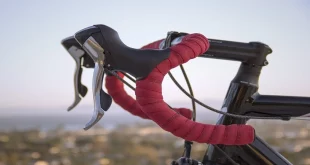Yes, training wheels can be installed on a mountain bike to provide stability for beginners. Are you a beginner rider looking to gain confidence on your mountain bike?
Or perhaps you have a child who wants to join you on your off-road adventures? If so, you may be wondering if it’s possible to put training wheels on a mountain bike. The answer is yes! While mountain bikes are typically designed for more advanced riders navigating challenging terrains, training wheels can be added to provide extra stability and support for beginners.
In this article, we’ll explore the benefits of using training wheels on a mountain bike, discuss the installation process, and provide some tips for getting started. By the end, you’ll have a clear understanding of how training wheels can help you or your little one take those initial steps into the exciting world of mountain biking.
Understanding Mountain Bikes
Mountain bikes are designed for rugged off-road terrain, making them the perfect choice for adventurous riders who seek thrills beyond the well-paved road. These bikes are built to handle challenging trails, rocky paths, and uneven surfaces. Their key characteristics distinguish them from other types of bicycles, providing superior performance in the great outdoors.
In this section, we will delve deeper into the understanding of mountain bikes, emphasizing their purpose for off-road and rough terrain riding. We will also explore the need for balance and maneuverability, highlighting why these attributes are crucial for maximizing the mountain biking experience.
So, let’s dive in!
Key Characteristics Of Mountain Bikes:
- Suspension: Mountain bikes are equipped with front suspension forks and sometimes rear suspension as well. These suspension systems absorb shocks and bumps, providing a smoother ride on rough terrain.
- Wide and knobby tires: The tires on mountain bikes are wider compared to road bikes, offering better traction and stability on loose dirt, gravel, and mud. The deep tread patterns, often with knobs, enhance grip and control.
- Strong frame: Mountain bike frames are built to withstand the demands of off-road riding. They are typically made of durable materials such as aluminum, steel, or carbon fiber, ensuring strength and resilience.
- Disc brakes: Mountain bikes commonly feature hydraulic or mechanical disc brakes. These provide excellent stopping power and responsiveness, even in wet and muddy conditions.
- Gear systems: Mountain bikes have a wide range of gears, allowing riders to conquer various inclines and declines effortlessly. They enable smooth shifting and efficient pedaling, regardless of the terrain.
Emphasis On Their Purpose For Off-Road And Rough Terrain Riding:
- Off-road capability: Mountain bikes excel in navigating through unpaved trails, forest paths, and rugged terrains that would challenge other types of bicycles. Their design and features make them well-suited for conquering the great outdoors.
- Suspension for bumpy terrain: The suspension on mountain bikes absorbs the impact of rough surfaces, reducing fatigue and enhancing comfort. This enables riders to tackle uneven trails and enjoy a smoother ride.
- Traction and stability: The wider, knobby tires on mountain bikes provide enhanced traction and stability, ensuring better control on loose and unpredictable terrain. This characteristic is vital for maintaining balance and rider confidence.
- Durability for rugged conditions: Mountain bikes are built to withstand the rigors of off-road riding, including encounters with rocks, roots, and other obstacles. Their sturdy frames and components are designed to withstand the demands of rough terrains.
Understanding these key characteristics and the purpose of mountain bikes emphasizes their suitability for off-road and rough terrain riding. With their balance, maneuverability, and rugged features, mountain bikes offer an exhilarating and engaging experience for adventure-seekers who want to explore the trails less traveled.
Challenges In Attaching Training Wheels To A Mountain Bike
Cycling is a fantastic activity that offers a great way to stay active and explore the outdoors. As a beginner, you may be wondering if it’s possible to attach training wheels to a mountain bike to make it easier to ride.
In this section, we will address the challenges of attaching training wheels to a mountain bike and explore the impact they have on the bike’s stability, balance, maneuverability, and handling.
Addressing The Differences Between Mountain Bikes And Children’s Bikes:
- Mountain bikes are designed for off-road terrains and are equipped with features that allow for better control, stability, and maneuverability over rough terrain.
- Children’s bikes, on the other hand, are typically smaller in size and have a simpler design, making them suitable for beginners.
The Effect Of Training Wheels On The Bike’s Stability And Balance:
- Training wheels provide extra support and stability, making it easier for beginners, especially children, to learn to ride a bike.
- However, attaching training wheels to a mountain bike can affect its stability and balance. Mountain bikes are designed to handle rough terrains and require a certain level of balance to navigate these obstacles effectively.
- Training wheels can create an artificial sense of stability, which can hinder the development of the rider’s balance skills.
The Impact On The Bike’s Maneuverability And Handling:
- Mountain bikes are known for their maneuverability and nimble handling, allowing riders to make quick turns and navigate through challenging terrains.
- Attaching training wheels to a mountain bike can significantly impact its maneuverability. The wider base created by the training wheels can make it difficult to make sharp turns or navigate tight corners.
- Riders may find it challenging to control and handle the mountain bike with training wheels, which can limit their ability to fully enjoy the off-road experience.
While it may be tempting to attach training wheels to a mountain bike for beginners, it’s important to consider the challenges they pose. Understanding the differences between mountain bikes and children’s bikes, as well as the effect of training wheels on stability, balance, and maneuverability, will help you make an informed decision about learning to ride a mountain bike.
Remember, practice and gradual progression are key to mastering the art of mountain biking.
Alternative Options To Training Wheels
Mountain biking can be a thrilling, adrenaline-pumping adventure, but for beginners or those lacking balance skills, the idea of riding without training wheels on rough terrain can be intimidating. Fear not! There are alternative options that can help you develop your skills and build confidence on a mountain bike.
In this section, we will explore some of these alternatives and how they can assist you in your journey to becoming a skilled mountain biker.
Explore Alternative Methods For Beginners Or Those Lacking Balance Skills
- Balance bikes: One popular option for beginners is the use of balance bikes. These bikes are designed without pedals, allowing riders to focus solely on balance and coordination. By using their feet to propel themselves forward and maintain balance, riders can learn to control the bike and build core biking skills.
- Training sessions: Another alternative is the option of seeking professional guidance through training sessions. Certified instructors can provide personalized coaching, focusing on specific areas where you may need improvement. They can teach you proper biking techniques, help you develop balance skills, and provide valuable tips and tricks to enhance your mountain biking experience.
- Beginner-friendly trails: Exploring beginner-friendly trails can also be an excellent way to build your skills and confidence. These trails often feature smoother surfaces, gentle slopes, and less technical challenges, allowing you to gradually progress from easier to more challenging terrain. Start with these trails to gain experience and gradually build your biking abilities.
- Group rides: Joining group rides or participating in organized mountain biking events can be a fantastic opportunity to learn from more experienced riders. Riding alongside others can provide you with guidance, motivation, and support as you navigate the trails. It’s a chance to observe their techniques, learn from their experiences, and exchange tips with fellow enthusiasts.
Discuss The Use Of Balance Bikes For Skill Development
Balance bikes are a great way for beginners to develop their balance and coordination skills without the complexity of pedals getting in the way. Here are some key benefits of utilizing balance bikes:
- Balance bikes allow riders to focus solely on learning the art of balancing and steering, which are essential skills when riding a mountain bike. By concentrating on these fundamental aspects, beginners can quickly gain confidence and control.
- As balance bikes have no pedals, riders can use their feet to propel themselves forward, stop, and maintain balance. This freedom of movement helps riders become more comfortable with the bike and gain a stronger sense of control.
- Mastering balance and coordination on a balance bike can help beginners transition smoothly to a traditional mountain bike. The skills learned on a balance bike lay a solid foundation for more advanced biking techniques, such as cornering, braking, and tackling obstacles.
Mention The Option Of Seeking Professional Guidance For Training And Skill Improvement
Seeking professional guidance is another viable option for beginners looking to improve their mountain biking skills. Here’s why professional training can make a significant difference:
- Certified instructors possess in-depth knowledge and expertise in mountain biking. They can provide personalized coaching tailored to your specific needs, enabling you to progress faster and more effectively.
- Professional trainers can teach you proper biking techniques, including body positioning, braking, and efficient pedaling. By mastering these essential skills, you’ll not only improve your performance but also reduce the risk of injuries on the trails.
- Training sessions with experts offer a structured approach to learning, focusing on skill development and gradual progression. They can introduce you to advanced techniques, such as navigating tricky terrain, tackling steep descents, and performing jumps, once you have mastered the basics.
Remember, if you’re new to mountain biking or lacking balance skills, training wheels may not be the answer. Instead, explore alternatives such as balance bikes, professional guidance, beginner-friendly trails, and group rides. These options provide a solid foundation for skill improvement and will have you confidently tackling mountain bike trails in no time.
Pros And Cons Of Using Training Wheels On A Mountain Bike
Discuss The Potential Benefits Of Using Training Wheels On A Mountain Bike
Using training wheels on a mountain bike can be a controversial topic, as it goes against the nature of mountain biking as a challenging and skill-driven sport. However, there are some potential benefits to consider when thinking about training wheels for mountain biking:
- Stability: One of the main advantages of training wheels is the added stability they provide. For beginners, especially children or those new to riding a mountain bike, training wheels can lend a sense of security, helping them feel more balanced and confident on the bike.
- Reduced fear: Training wheels can help alleviate the fear of falling and the associated anxiety that comes with it. By providing extra support as riders navigate rough terrains, training wheels can give beginners the freedom to focus on learning other biking skills without constantly worrying about keeping their balance.
Highlight The Drawbacks And Limitations Of Relying On Training Wheels
While training wheels have their benefits, it is important to recognize their drawbacks and limitations as well. Here are some points to consider:
- Limited skill development: Relying on training wheels can hinder the development of essential skills needed for mountain biking. Balance, core strength, and bike control are fundamental skills that can only be learned by riding without additional support. Training wheels may create a false sense of skill and prevent riders from fully learning these necessary abilities.
- False sense of security: Having training wheels can give riders a false sense of security, leading them to attempt trails and terrain beyond their skill level. This can be dangerous and increase the risk of accidents and injuries. It is crucial for riders to understand their limitations and progress at their own pace.
Provide A Balanced Perspective On Their Effectiveness In Improving Riding Skills
When considering training wheels for a mountain bike, it is essential to weigh the pros and cons carefully. Here are some key points to keep in mind:
- Transitioning tool: Training wheels can serve as a useful transitional tool for absolute beginners or those lacking confidence. They can help riders gradually build their skills and gradually wean themselves off the training wheels when they feel more comfortable and balanced.
- Temporary solution: It is important to view training wheels as a temporary solution rather than a long-term fix. Over time, riders should aim to remove the training wheels and focus on developing their biking skills without reliance on additional support.
- Individual preferences: Every rider is different, and some may find that training wheels work well for them, enabling them to gain confidence and enjoy the sport. It is crucial to respect individual preferences and choices, as long as safety is prioritized.
While training wheels on a mountain bike may have some benefits, they should be used with caution and as a temporary stepping stone towards more independent riding. It is important to strike a balance between stability and skill development, always keeping safety in mind.
Ultimately, the decision to use training wheels should be guided by the rider’s confidence, ability, and willingness to grow as a mountain biker.
Training Wheels Adaptations For Mountain Bikes
If you’re a novice mountain biker who wants a little extra stability, you might find yourself wondering if you can put training wheels on a mountain bike. While training wheels are typically associated with kids’ bikes, it’s not completely out of the question to adapt them for mountain bikes.
In fact, there are specialized training wheel options available that cater specifically to the needs of mountain bikers. In this section, we will delve into the introduction to these adapted training wheels, discuss their features and benefits, and examine their compatibility with specific mountain bike models.
Introduction To Specialized Training Wheel Options For Mountain Bikes
When it comes to specialized training wheel options for mountain bikes, there are a few key points to consider:
- Designed for rugged terrain: These training wheels are specifically engineered to withstand the challenges of off-road riding. They are built with durable materials that can handle rocks, roots, and uneven surfaces.
- Enhanced stability: The adapted training wheels provide extra stability, especially for riders who are new to mountain biking. This added support can boost confidence and help riders navigate tricky sections with ease.
- Retaining maneuverability: While stability is crucial, it’s equally important to ensure that the training wheels don’t hinder the maneuverability of the mountain bike. Specialized options are designed to provide stability without sacrificing the bike’s agility.
Features And Benefits Of Adapted Training Wheels
Here are some of the main features and benefits that come with adapted training wheels for mountain bikes:
- Adjustable height: These training wheels can be adjusted to various heights, allowing riders to find the perfect balance between stability and freedom of movement.
- Quick installation: Most adapted training wheels can be easily attached and removed, making them convenient for riders who want to switch between using training wheels and riding without them.
- Increased confidence: The extra stability provided by these training wheels helps beginners build confidence and progress their skills at their own pace. This can lead to a more enjoyable and fulfilling mountain biking experience.
- Safety and balance: By preventing the bike from tipping over, these training wheels offer a safer riding experience. They also help riders maintain balance, particularly when navigating tricky sections or while climbing challenging ascents.
Compatibility With Specific Mountain Bike Models
Before investing in adapted training wheels, it’s important to ensure they are compatible with your mountain bike model. Different manufacturers design training wheels to fit specific bike models, so it’s essential to check compatibility before making a purchase. Some key factors to consider include wheel size, frame design, and axle compatibility.
You can usually find this information in the product description or consult with a specialist at your local bike shop for personalized advice.
With the availability of specialized training wheel options for mountain bikes, riders can now enjoy increased stability while exploring the thrilling world of off-road cycling. These adaptations offer a gateway for beginners to gain confidence and develop their skills, all while maintaining the maneuverability and excitement that mountain biking has to offer.
Expert Opinions On Using Training Wheels On A Mountain Bike
Riding a mountain bike is an exhilarating experience, but it can also be challenging, especially for beginners. One of the questions that often arises is whether it is possible to put training wheels on a mountain bike. To bring you accurate information, we gathered insights from experienced cyclists and experts in the field to discuss their viewpoints on the practicality or effectiveness of training wheels on mountain bikes.
Gather Insights From Experienced Cyclists And Experts In The Field:
- Experts emphasize the importance of learning proper balance and bike control techniques right from the start.
- Many experienced cyclists believe that using training wheels on a mountain bike can hinder the development of essential skills needed for off-road riding.
- Experts suggest that it’s best to start with an appropriate beginner-level mountain bike that is easier to handle and gradually progress as skills improve.
Discuss Their Viewpoints On The Practicality Or Effectiveness Of Training Wheels On Mountain Bikes:
- Some cyclists argue that training wheels may provide temporary stability for beginners, allowing them to gain confidence before transitioning to riding without assistance.
- Others believe that training wheels are not suitable for mountain bikes as they are specifically designed for flat and even surfaces, such as pavement.
- Critics point out that mountain biking involves riding on varied terrain, and training wheels may cause instability and hinder maneuverability when faced with obstacles like rocks, roots, or uneven surfaces.
By presenting a range of opinions, we aim to provide a well-rounded perspective on the use of training wheels on mountain bikes. While some cyclists may find value in using training wheels as a stepping stone, it is generally recognized that developing proper balance and bike control techniques is crucial for success in mountain biking.
It is recommended to focus on learning these skills through practice and gradually progressing to more challenging trails with the guidance of experienced riders.
Frequently Asked Questions For Can You Put Training Wheels On A Mountain Bike?
Can You Add Training Wheels To A Mountain Bike?
Yes, you can add training wheels to a mountain bike. However, it’s uncommon and not recommended due to the bike’s design. Mountain bikes are built for off-road terrain, and training wheels can restrict the bike’s maneuverability and affect its balance.
It’s better to learn proper bike handling skills without training wheels if you want to ride a mountain bike.
Why Are Training Wheels Not Recommended For Mountain Bikes?
Training wheels are not recommended for mountain bikes because they affect the bike’s balance, maneuverability, and handling on off-road terrain. Mountain bikes have specific designs, such as wide tires and suspension systems, that make them unsuitable for training wheels. It’s better to develop the necessary skills to ride a mountain bike without training wheels.
What Are The Alternatives To Training Wheels For Mountain Bikes?
Instead of training wheels, there are other ways to perfect your mountain biking skills. Start by practicing on flat and easy trails, gradually progressing to more challenging terrains. You can also seek guidance from experienced riders or take mountain bike classes to improve your balance, control, and handling skills.
Building confidence and technique is key to mastering mountain biking without training wheels.
Conclusion
To sum up, the question of whether you can put training wheels on a mountain bike ultimately comes down to personal preference and specific circumstances. While it is technically possible to install training wheels on a mountain bike, it is important to consider the purpose and intended use of the bike.
Training wheels are primarily designed for beginners and young riders who are learning to balance and pedal. Mountain bikes, on the other hand, are built for off-road adventures and require agility and maneuverability. Adding training wheels may hinder the bike’s performance and limit its capabilities on challenging terrains.
It is also worth mentioning that training wheels can affect the rider’s skill development and limit their ability to learn proper balance and handling techniques. It is advisable to consult with a bike expert or professional before making any modifications to your mountain bike, ensuring that you make an informed decision based on your individual needs and goals.
So, before attaching training wheels, consider the specific requirements and objectives of your mountain biking adventures.
 CommutingLife Explore The World On Two Wheels
CommutingLife Explore The World On Two Wheels





